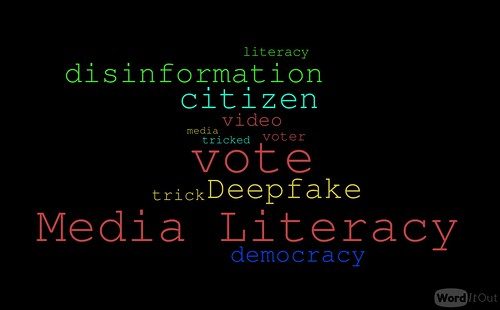Introducing Students to Dangers of Deepfake Videos
Author: Wesley Fryer
Go to Source
This week as a media literacy activity during our start of class “Wonder Link” time, I’ve introduced my 5th and 6th grade students briefly to “Deepfake Videos” and discussed together the dangers they pose for voters, consumers, and others. I’m sharing this Instagram video about Mark Zuckerberg, which was created as part of the Bill Posters “SPECTER” project. Take a few seconds and watch it, it’s not only a bit unnerving but also on point from the perspective of social media platform critics like Shoshana Zuboff (@shoshanazuboff). Several other examples from the SPECTER project are available on the same Instagram channel.
View this post on Instagram[NEW RELEASE] ‘I wish I could…’ (2019) Mark Zuckerberg, founder of @facebook reveals the ‘truth’ about privacy on #facebook . This artwork is part of a series of AI generated video works created for ‘Spectre’ – an immersive exploration of the digital influence industry, technology and democracy. . Art by Bill Posters & @danyelhau for @sheffdocfest @sitegallery #artnotmisinformation #thefutureisntprivate #deepfakes #deepfake #spectreknows #surveillancecapitalism #privacy #democracy #dataism #contemporaryartwork #digitalart #generativeart #newmediaart #codeart #markzuckerberg #artivism #contemporaryart
I next showed my students this 76 second video from the Washington Post, which explains how the video was faked, and a little about the dangers these may (should read ‘WILL’) pose in upcoming U.S. elections. We briefly discussed who Mark Zuckerberg is, how Facebook works and makes money (many of my students didn’t know / don’t know it’s from advertising and selling access to user data). I pulled up a Facebook post from last Sunday which I shared from a local burger restaurant, and gave the example that if the owners of “The Impossible Burger” want to start selling to people in Oklahoma City, they might buy access from Facebook to people in our area who like burgers. Facebook knows I’m likely a burger fan from that location-based post. I did not mention the term “surveillance capitalism” to my students at this point… but we’re really laying the media literacy foundations for understanding advertising and how media-based brain hacking / manipulation works.
In one of my classes today students were asking WHY people are manipulating videos in these ways. To further stimulate student thinking I shared this Twitter video from this recent Guardian article highlighting the Chinese iPhone app Zao. That example shows how people want to use “Deepfake” video technology for fun, to put their face on clips from popular Hollywood movies. The question I posed to students after that was, “How do you think this could be dangerous or a problem for people or for our society overall?”
These were and are excellent media literacy conversations! Facilitating and encouraging those conversations is a key goal of the 5th and 6th grade computer classes I’m teaching this year focusing on Digital Literacy, Media Literacy, Digital Citizenship and keyboarding. Check out all my shared lessons and curriculum resources on mdtech.casady.org.
If you discuss “Deepfake videos” with students, be aware that some news articles and Google searches will discuss how this technology is intersecting with pornography. The January 2019 CNN article, “When seeing is no longer believing: Inside the Pentagon’s race against deepfake videos” is an example. It’s an excellent article and resource, but because of some of the references to pornography, teachers will want to carefully consider if it’s appropriate to share with younger students.
Of course all these issues need to be addressed eventually with students before they graduate from high school. Sexting is a huge issue and problem which falls under the curricular umbrellas of student health, wellness, and digital citizenship. Before addressing that, however, as a teacher you may want to consult with your school psychologist, counselor, and/or building principal for guidance. One thing I appreciated about the above links to the SPECTER project is the video content was appropriate for the classroom and my students: No profanity is included in the videos I watched and nothing is racey. Certainly challenging and powerful, however, which is what we need to share and “catalyze” media literacy mini-lessons on topics like this.
If you enjoyed this post and found it useful, consider subscribing to Wes’ free, weekly newsletter. Generally Wes shares a new edition on Monday mornings, and it includes a TIP, a TOOL, a TEXT (article to read) and a TUTORIAL video. You can also check out past editions of Wes’ newsletter online free!
Did you know Wes has published several eBooks and “eBook singles?” 1 of them is available free! Check them out! Also visit Wes’ subscription-based tutorial VIDEO library supporting technology integrating teachers worldwide!
MORE WAYS TO LEARN WITH WES: Do you use a smartphone or tablet? Subscribe to Wes’ free magazine “iReading” on Flipboard! Follow Dr. Wesley Fryer on Twitter (@wfryer), Facebook and Google+. Also “like” Wes’ Facebook page for “Speed of Creativity Learning“. Don’t miss Wesley’s latest technology integration project, “Show With Media: What Do You Want to CREATE Today?“

